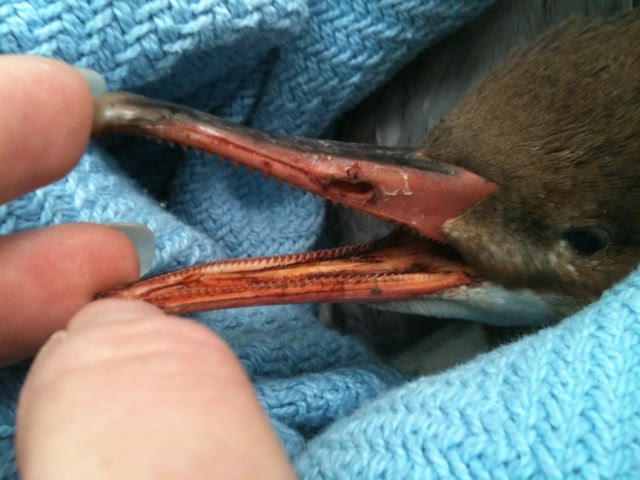We last checked in with Mergus, the female Common Merganser (Goosander, if you will - Mergus merganser) on Dec. 21 / day 1 - her arrival - and with this post, we're pretty much still there. Here's the first post, in case you missed it.
Since then (it has been a month and week since she arrived!) we've reconsidered her injuries. We think she was not directly struck by a vehicle, so much as 'rolled.' Hindsight, we now have the luxury of time to ponder these things.
Her left eye, seen below, was what we used as our standard for 'normal' when assessing the right eye. The bloodied and dislocated beak, slightly weak left leg, but perfectly intact wings leads me to think that she was 'rolled' by a vehicle. Either sitting on, or next to the road, her wings would have already been tucked when jostled/tumbled by a passing vehicle. Beak/head are extremities, and not well padded, so more susceptible to being damaged making contact with the road.
 |
| Female Common Merganser (Mergus merganser), detail of beak: nostril, tongue, serrations. |
 |
| Upper mandible and lower mandible (the collective 'beak') did not align when closed - not broken, but dislocated. |
Beaks and eyes are understandably very important for a bird: a one-eyed merganser could possibly survive in the wild, but if the beak was useless, it'd starve. Hydration being most important, and not having the fluids or needles required for subcutaneous administration, the 'rural medicine' method was pretty basic: water dripped on the tongue, every two hours. Roughly one teaspoon per session. Not enough, but couldn't do much more without additional stress. At least the exposed bit of lower beak and tongue served as an easy option for drips, without having to touch her, restrain her, or move her at all.
 |
| Merg's swollen right eye, day 1, pre-ointment. |
Glad we had it on hand, as the Sunday before Christmas is never a good time to call a vet. Or have the flu, but at least I was able to call my rehabber every 30 minutes with a new question!
Due to the very fresh nature of the injuries, and not wanting to aggravate or further stress a bird already likely in shock, the decision was made to otherwise provide water, darkness, warmth, and just wait. As folks who have been through major trauma can attest, sometimes time is half the battle.
Rehab is 10% headache and 90%
heartbreak, so if she was alive in the morning, we'd take it from there.
*** Texas is one of those states where you need permits for even transporting injured wildlife, so
we followed our rehabber's instructions and stabilizing the bird as best as possible with hopes that she could be transported with less risk (to her). Some states have a 'Good Samaritan Clause' for folks bringing injured wildlife to rehabbers - we wish TX would get on board with that.
* post is from a month after the fact
we followed our rehabber's instructions and stabilizing the bird as best as possible with hopes that she could be transported with less risk (to her). Some states have a 'Good Samaritan Clause' for folks bringing injured wildlife to rehabbers - we wish TX would get on board with that.
* post is from a month after the fact
Sneak peek: she did wake up on day two! This pic is likely from day three, though...



No comments:
Post a Comment